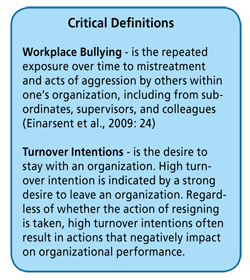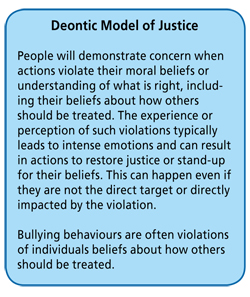Bullying and the Bigger Picture: The Impact of Individual and Unit-level Bullying on Turnover Intentions
By Kyla Nicholson, CHRP
This Research Briefing is a service from BC HRMA’s research group. Our aim is to make it easier and quicker for HR professionals to find and apply the latest and best people management insight to their challenges and projects. This paper contains a concise and practical summary of a recent academic finding that should shape your HR practices.
Summary
In the study “Escaping bullying: The simultaneous impact of individual and unit-level bullying on turnover intentions”, Houshmand, O’Reilly, Robinson and Wolff attempt to understand the impact that bullying in a work unit has on individual employees’ turnover intentions, even when these employees are not the direct target of the mistreatment. The study finds that bullying increases turnover intentions in not only the individual who is the target of the bullying, but also at the work unit level.
 Bullying contaminates the overall work environment. Those within it recognize that the behaviours being tolerated violate their beliefs about the way that people should be treated; thus, turnover intention at the work unit level increases. In fact, turnover intention is reported to be highest in those that do not directly experience bullying, perhaps because their own relatively “good” treatment demonstrates the discrepancy in treatment that exists.
Bullying contaminates the overall work environment. Those within it recognize that the behaviours being tolerated violate their beliefs about the way that people should be treated; thus, turnover intention at the work unit level increases. In fact, turnover intention is reported to be highest in those that do not directly experience bullying, perhaps because their own relatively “good” treatment demonstrates the discrepancy in treatment that exists.
The findings of the study are important as they stress that the impacts of bullying on turnover intention go beyond the target of the bullying to the broader work unit. Moreover, while turnover may be one costly consequence of bullying, those employees that stay with the organization while desiring/looking for opportunities to leave may impact organizational performance negatively in an even greater way.
Effective HR programs to identify and address bullying when it occurs are necessary, but perhaps more critical is to establish the foundations for a respectful workplace culture and incorporate these expectations into the full suite of HR programs that are present in an organization.
Background
The impacts of harmful workplace behaviours such as harassment, aggression, social undermining and bullying have been studied for years, indicating a common recognition for the prevalence of such challenging behaviours in workplace settings. Typically, the focus of study has been on the impact of such behaviours on the target. The common response found from targets has been the desire to get away from the mistreatment.
This study recognizes what we may all know intuitively, that the impact of bullying, which is often an observable or felt behaviour, goes beyond the impacts to the individual being targeted and impacts the culture and behaviours of the overall workplace unit. Thus, this study aims to understand the impacts that bullying behaviours can have on both those who are the direct target of the bullying and those who are members of the common work unit.
 The researchers sought to understand the impacts of work unit-level bullying on turnover intentions using a deontic model of justice (see sidebar). This model puts forth that people can be concerned and driven to take action over treatment that they perceive to be unfair or unjust, even if they aren’t the target, because that treatment crosses their moral beliefs/understandings of how others should be treated. Infringing on these beliefs can cause an intense emotional reaction because the person feels that certain standards that they have tried to uphold have been violated. Anger toward the person who is causing this situation, those who are letting it go on, and the need to take actions that will reinforce or stand-up for the moral order to which they align, are often strongly felt.
The researchers sought to understand the impacts of work unit-level bullying on turnover intentions using a deontic model of justice (see sidebar). This model puts forth that people can be concerned and driven to take action over treatment that they perceive to be unfair or unjust, even if they aren’t the target, because that treatment crosses their moral beliefs/understandings of how others should be treated. Infringing on these beliefs can cause an intense emotional reaction because the person feels that certain standards that they have tried to uphold have been violated. Anger toward the person who is causing this situation, those who are letting it go on, and the need to take actions that will reinforce or stand-up for the moral order to which they align, are often strongly felt.
Retaliation and resistance are two types of deontic reactions. While retaliation may be more likely to bring further retaliations, resistance can be a less provocative response in a workplace. Turnover intentions, withdrawal and quitting are common forms of resistance in the workplace. From a deontic model perspective, whether one is the victim or the active or passive observer of workplace bullying, taking resistance-based actions to undermine a bully may be seen as a moral obligation.
Hypotheses and Results
Hypothesis 1: Being the target of bullying is positively related to turnover intentions, independent of the extent of bullying in one’s work unit.
Hypothesis 2: Work unit-level bullying is positively related to turnover intentions, independent of the extent to which one is a direct target of bullying.
Hypothesis 3: There is an interaction effect between direct bullying and work unit-level bullying such that the relationship between work unit-level bullying and turnover intentions is stronger for individuals who experience less direct individual level bullying than for individuals who experience more.
The researchers tested the above hypotheses by collecting data from nurses in 41 units of a large health authority in a western Canadian city.
The results were clear…
All three hypotheses were supported by the study.
It was found that individuals who are the target of bullying have higher turnover intentions. This is not surprising as wanting to get away from the mistreatment seems to be a rationale response. Furthermore, even if the individual who is the target of bullying is not able to leave the organization, the intention to leave, should the opportunity arise, may provide them with some psychological protection from the bullying behaviour.
Bullying also leads to turnover intentions at the work unit level. The impact of bullying at this level is in addition to the actual bullying that an individual receives; it goes beyond this individual to others in the collective work unit. As people observe or hear about bullying situations in the workplace, empathetic reactions lead to an understanding of the unjust treatment being experienced, creating deontic reactions such as turnover intention.
Further, the study found that turnover intentions are actually stronger in those that do not experience the bullying. This may be due to the fact that their own treatment provides a standard against which the discrepancy in treatment can be measured; highlighting the level of mistreatment being inflicted on others in the workplace.
The findings, examined in light of the deontic model, are important as they put turnover intention into a context that may not always be considered. Often the targets of bullies are characterized as “victims” and are often portrayed as weak. The desire to leave the situation in which the mistreatment is occurring may be perceived as fleeing. This model, however, puts turnover intention in line with an act of resistance intended to undermine the power source of the bully and often the organization which has failed to take action to address the bullying and, thus, is perceived in a similar light to the bully themselves. It highlights that actions of resistance intended to stand-up for moral justice are not just to be expected from the target of bullying, but also from those in the greater work unit who are, themselves, morally outraged by the behaviours.
Implications for HR Professionals
HR professionals need to fully understand the impact of bullying in the workplace in order to understand the potential consequences for organizational performance. A critical learning from this study is that the impact of bullying (increased turnover intention) is not just to the individual who is the target of the bullying, but expands beyond that to others in the work unit who are reacting to behaviours that go against their morals and/or beliefs about what fair and proper treatment should be.
Consequences of turnover intentions are many and may include decreased discretionary effort impacting quality and output; lack of emotional commitment impacting overall team cohesiveness and collaboration; and the cost of quitting, including not only the cost of hiring and retraining, but the cost of overtime, lost morale, and decreased productivity for those who are left to provide coverage during a vacancy.
While turnover intention does not always lead to the action of turnover, the likelihood is increased in highly competitive industries, and when recognized top performers find themselves in bullying environments as these individuals have the skills, confidence, and network to facilitate their move out of the workplace that tolerates bullying behaviours.
HR practitioners should gain a clear understanding of their legal obligations to address bullying. This has been brought top of mind with the recent ratification of Bill 14, which addresses the broader duties employers have for supporting mental health. Greater understanding of which HR programs can address workplace bullying and its impacts is required.
HR programs must proactively work to align around and establish a respectful workplace culture. The specific programs that will most impact establishing such a culture will differ by organization and must be determined based on the existing culture and opportunities it presents (e.g., a values-based recognition program in one organization may be highly successful, but may be ignored or seen as “fluffy” in another). Examining HR programs and determining which can have the greatest impact in supporting a respectful workplace climate can support the HR department to ensure resources are applied to the most effective programs to proactively address bullying in the workplace.
However, the HR professional needs to be cautioned that this is only one causal factor in turnover. This article should also be read in conjunction with other articles on turnover found on the BC HRMA web site: www.bchrma.org/resources/knowledge-centre.
This article is based on the following research paper: “Escaping bullying: The simultaneous impact of individual and unit-level bullying on turnover intentions.” Houshmand, M.; O’Reilly, J., Robinson, S.; Wolff, A. Publisher: Human Relations July 2012 vol. 65 no. 7 901-918
Share your experiences…
Tell us how the insights from this study could affect change in your organization. What practices in your organization are most in need of attention when looked at through the lens of collective felt trust? Contact us at research@bchrma.org.
(PeopleTalk: Fall 2012)







